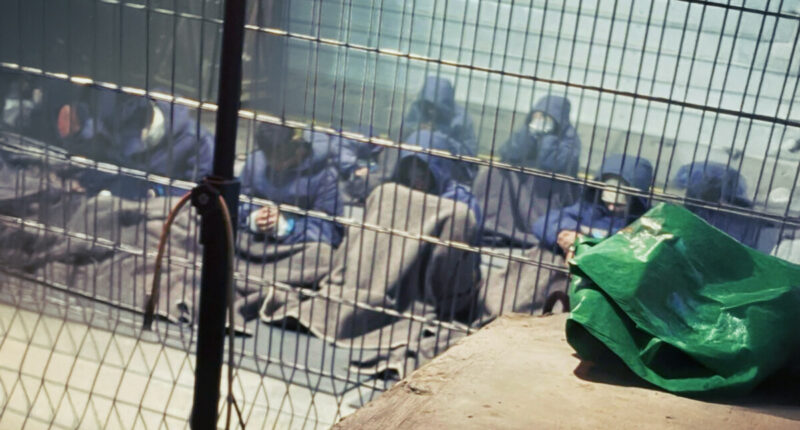Share this @internewscast.com
In a disturbing development, Gaza health authorities report that 135 bodies of Palestinians, returned by Israel, have been identified as originating from the notorious Sde Teiman detention center. This facility has long faced allegations of widespread torture and unlawful executions. The findings have intensified calls for a comprehensive international inquiry into the methods employed in Israeli detention centers.
According to The Guardian, documents accompanying the remains—consisting of tags written in Hebrew—confirm their origin at Sde Teiman, a military base and prison camp located in the Negev desert. These documents also reference DNA tests conducted at the site, providing crucial evidence. Dr. Munir al-Bursh, the director general of Gaza’s health ministry, emphasized, “The document tags inside the body bags clearly indicate that the remains were held at Sde Teiman.”
Scrutiny of the facility has been ongoing, with reports from both Israeli and international media highlighting severe mistreatment of Palestinian detainees. Allegations include prisoners being blindfolded and caged, shackled to hospital beds, and forced to wear diapers during interrogations. Previous reports by The Guardian have depicted a grim picture of physical abuse, sleep deprivation, and degrading treatment at the facility, supported by photos and whistleblower accounts.
Earlier, the Israeli military launched a criminal investigation into the deaths of 36 prisoners at this facility, an inquiry that remains active. However, the recent revelations from Gaza’s medical professionals, backed by forensic examinations of the returned bodies, have strengthened suspicions that these were not isolated incidents but rather part of a systematic practice of torture and extrajudicial killings.

Doctors in Khan Younis have provided statements, supported by a report, indicating that the bodies showed signs of “direct gunfire at point-blank range” and “bodies crushed beneath Israeli tank tracks.” These findings suggest acts of murder, summary executions, and systematic torture.
These bodies, returned under a U.S.-brokered truce agreement, arrived in Gaza in sealed body bags marked only with numeric codes, devoid of names. As health staff continue the painstaking process of identification through DNA testing and photographs, the link between these deaths and Sde Teiman grows clearer. Many of the remains are so severely mutilated that they are beyond recognition, amplifying the tragedy of this human rights crisis.
One of the victims, identified by his brother Rami, was Mahmoud Ismail Shabat, a 34-year-old from northern Gaza. “What hurt us the most was that his hands were tied, and his body was covered with clear signs of torture,” his brother said. Shabat’s mother added, “All our hostages returned tortured and broken. Where is the world?”

The findings align with multiple testimonies from former detainees and whistleblowers who worked at or visited the Sde Teiman facility. A former Israeli medic told The Guardian that “I did witness a patient from Gaza being brought with a gunshot wound to the left chest. He was also blindfolded, handcuffed, and naked as he arrived at the emergency department.” In another case, a detainee’s hand was amputated “because the wrists had become gangrenous due to handcuffing wounds.”
The testimonies describe a harrowing pattern: Palestinian detainees captured during military raids were transported directly to Sde Teiman, where abuse reportedly continued under administrative detention. Some detainees were seized while receiving treatment in Gaza hospitals and subsequently subjected to degrading treatment. “These were patients who had been captured by the Israeli army while being treated in Gaza hospitals,” said a whistleblower. “They had limbs and infected wounds. They were moaning in pain.”
Journalist Shadi Abu Seido, who was detained at Sde Teiman for 100 days, said conditions were so brutal that “many died in detention, others lost their minds.” Seido, who was stripped naked and kept handcuffed and blindfolded for weeks, recalled that guards would bring dogs into his cell and force them to urinate on prisoners. “When I asked why I had been arrested,” he said, “they answered: ‘We have killed all the journalists. They died once. But we brought you here and you will die hundreds of times.’”
Human rights organizations say the details emerging from these accounts indicate crimes that go far beyond abuse. Physicians for Human Rights Israel (PHR) says the confirmed signs of torture “corroborate what we have exposed over the past two years” and demonstrate a pattern of “systematic torture and killings by soldiers and prison guards.”
“The signs of torture and abuse found on the bodies recently returned by Israel to Gaza are horrifying—yet, sadly, not surprising,” said Naji Abbas, director of the prisoners and detainees division at PHR Israel. The group is now calling for an independent international investigation to establish accountability for what it described as “extraordinarily grave violations of humanitarian law.”
Photos provided to The Guardian were reviewed by an Israeli doctor who previously worked at Sde Teiman. Speaking anonymously, the physician confirmed that one victim’s wrists showed signs consistent with “ischemic changes due to excessive restraints.” The doctor added, “This might be someone who was either injured and captured—thus died under Israeli custody—or someone who died due to injuries inflicted after his capture.”

In response to questions from The Guardian, the Israel Defense Forces (IDF) said it had referred the allegations of detainee abuse to the Israel Prison Service but declined to comment on claims that the bodies were held at Sde Teiman. The IDF has maintained that its facilities treat prisoners “appropriately and carefully” and that any claims of abuse are “examined and dealt with accordingly.”
However, human rights experts say such internal investigations lack credibility, pointing to Israel’s record of limited accountability for violations against detainees. The United Nations reports at least 75 Palestinians have died in Israeli custody since October 2023, underscoring what rights advocates describe as a worsening pattern of extrajudicial killings and medical neglect.
UN rapporteur Dr. Morris Tidball-Binz, a forensic science specialist, has called for “independent and impartial forensic assistance” to help identify victims and determine the causes of death. “The preservation and examination of the deceased are vital to ensure evidence is collected responsibly and justice is delivered transparently,” he said.
The scope of what occurred at Sde Teiman remains unclear. Israeli media reports and prisoner-guard testimony suggest up to 1,500 bodies of Palestinians are still stored at the facility. Human rights monitors warn that without access to the site, determining how many detainees died there—and under what circumstances—may be impossible.
For families in Gaza, the slow delivery of the dead compounds their grief with outrage. As one grieving mother said during an interview at Nasser Hospital, “They tortured our sons while the world was silent. Even in death, they came back bound and beaten.”
The mounting evidence of torture and killings at Sde Teiman has intensified calls for transparency and justice. Human rights organizations, journalists, and former detainees insist that only an international investigation—free from Israeli oversight—can uncover the truth. “The evidence is overwhelming,” said PHR. “What is missing now is accountability.”
















